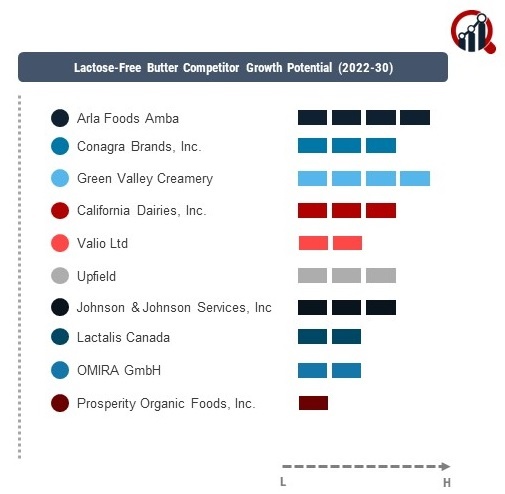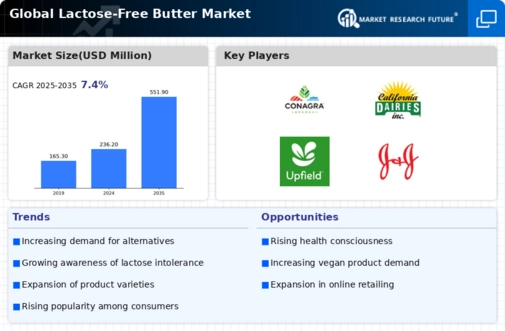Top Industry Leaders in the Lactose Free Butter Market
 The competitive landscape of the lactose-free butter market is characterized by a dynamic interplay of key players, strategic maneuvers, market share determinants, new entrants, and ongoing industry developments. As consumer preferences continue to shift towards healthier and dietary-conscious choices, the lactose-free butter segment has witnessed notable growth. Key players in this market have adapted various strategies to navigate the evolving landscape, and understanding these dynamics is crucial for assessing the overall competitive scenario.
The competitive landscape of the lactose-free butter market is characterized by a dynamic interplay of key players, strategic maneuvers, market share determinants, new entrants, and ongoing industry developments. As consumer preferences continue to shift towards healthier and dietary-conscious choices, the lactose-free butter segment has witnessed notable growth. Key players in this market have adapted various strategies to navigate the evolving landscape, and understanding these dynamics is crucial for assessing the overall competitive scenario.
Key Players:
- Arla Foods amba (Denmark),
- Conagra Brands Inc. (US),
- Green Valley Creamery (US),
- California Dairies Inc. (US),
- Valio Ltd (Finland),
- Upfield (Netherlands),
- Johnson & Johnson Services Inc. (US),
- Lactalis Canada (Canada),
- OMIRA GmbH (Germany),
- Prosperity Organic Foods Inc. (US)
Strategies Adopted:
To maintain a competitive edge, key players in the lactose-free butter market have embraced diverse strategies. These include product innovation, strategic partnerships, mergers and acquisitions, and geographical expansions. Companies are investing in research and development to introduce new variants and improve existing products, meeting the demands of health-conscious consumers.
Factors for Market Share Analysis:
Market share analysis in the lactose-free butter segment considers several factors. These include product quality, brand recognition, pricing strategies, distribution networks, and responsiveness to consumer preferences. Companies that effectively balance these elements tend to capture a larger market share, consolidating their positions as industry leaders.
New and Emerging Companies:
The lactose-free butter market has witnessed the emergence of new players, contributing to market diversification. These entrants often bring innovative products and disruptive business models, challenging established players. Notable new and emerging companies in this sector include Nutiva, Nature's Path, and Flora. Their strategies often revolve around leveraging health-conscious consumer trends and addressing specific dietary needs.
Industry News and Current Companies:
Ongoing industry news highlights the continuous efforts of existing companies to adapt to market dynamics. For instance, Arla Foods recently announced an expansion of its lactose-free product line, showcasing the company's commitment to catering to evolving consumer demands. Such initiatives reflect the industry's responsiveness to changing market trends.
Investment Trends:
Investment trends in the lactose-free butter market indicate a growing interest from both traditional and venture capital investors. These investments are primarily directed towards product development, marketing, and expanding production capacities. As the market matures, investors are keen on backing companies with a strong market position and the potential for sustained growth.
Overall Competitive Scenario:
The overall competitive scenario in the lactose-free butter market is marked by intense rivalry, with companies vying for consumer attention through various means. Differentiation strategies, cost leadership, and niche targeting are common approaches. Companies are focusing on building a loyal customer base by addressing concerns related to lactose intolerance and offering products that align with broader health and wellness trends.
Recent Developments
The lactose-free butter market experienced significant developments that shaped its trajectory. Notably, Kerry Group launched an enhanced formulation of its lactose-free butter, aiming to improve taste and texture. This move reflects the ongoing commitment of established players to refining their products and meeting consumer expectations.
Additionally, Valio Ltd. forged a strategic partnership with a leading e-commerce platform to expand its distribution network and reach a wider consumer base. This aligns with the trend of companies exploring new channels to enhance market penetration and accessibility.
Green Valley Creamery, a key player in the lactose-free dairy space, announced a series of collaborations with nutritionists to raise awareness about the benefits of lactose-free products. This move is indicative of the industry's proactive efforts to educate consumers and dispel myths surrounding lactose-free options.
Furthermore, Land O'Lakes invested in sustainable sourcing practices, aiming to enhance its environmental footprint and appeal to environmentally conscious consumers. Sustainability initiatives are becoming increasingly important in shaping consumer preferences, and companies are incorporating such practices into their overall strategies.

- Beta
Beta feature

